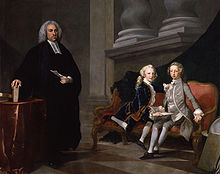Francis Ayscough
Francis Ayscough | |
|---|---|
 Francis Ayscough, Dean of Bristol and tutor to King George III of Great Britain. From the painting by Richard Wilson, c. 1749.[1] | |
| Born | 19 December 1701 |
| Died | 16 August 1763 (aged 61) |
Francis Ayscough (19 December 1701 – 16 August 1763) was a tutor to George III and Clerk of the Closet to George’s father Frederick, Prince of Wales[2] and later Dean of Bristol Cathedral.[3]
Biography
[edit]Francis was born in the English county of Surrey on 19 December 1701 and baptised on 25 December in St Olave's Church, Southwark.[4] He was educated at Winchester College, where he gained a scholarship in 1715,[a] and at Corpus Christi College, Oxford, where he matriculated in 1717, graduating B.A. 1720, M.A. 1723, B.D. 1731, D.D. 1735.[7] He was initially rejected for a fellowship at Oxford, but was admitted after the intercession of the Bishop of Winchester, Richard Willis, who threatened to sack all of those involved if Ayscough was not appointed in 15 minutes.[8]

He was appointed as the first tutor to George who was to be the future King George III of Great Britain. Reportedly Ayscough was appointed by the intercession of Sir George Lyttlelton, who had some influence with George's father. Ayscough had married Anne Lyttleton who was George's sister.[8]
In 1735 it was Ayscough as Chaplain to the Prince of Wales who was called on to give a sermon to the House of Commons to commemorate the "martyrdom of Charles I".[9]
The boy's father retained Francis' services, but in 1749 he made a further appointment of an assistant to Ayscough. The new assistant, Lewis Scott, was a mathematician and a member of the Royal Society and it was through him that George III became the first British monarch to have a scientific education.[10]
On the death of Frederick in 1751 Ayscough and North were both replaced by the Whig politicians. Ayscough was replaced by the Bishop of Norwich, Thomas Hayter.
In 1754 he officiated at the wedding of William Pitt and Hester Grenville.[11] In 1755 he had a sermon published on the wrongs of "self murder".[12]
In 1756, Ayscough became the Canon (of 12th prebend) for Winchester Cathedral, 1756–1763,[13] Ayscough was also appointed to be the Dean of Bristol in 1761, a post that he also held until his death[14][15] which took place in Bristol on 16 August 1763; he was buried in Bristol Cathedral three days later.[4] Anne, his wife, outlived him and died in their house in London in 1776 aged 64. Ayscough's children included Anne Augusta who became Lady Cockburn, and George Edward Ayscough who was a Guards officer and sometime dramatist.
Notes
[edit]- ^ The Winchester register incorrectly has Ayscough continuing to Balliol College, Oxford and graduating B.A. in 1723:[5] this was Ayscough's brother, Gabriel[6]
References
[edit]- ^ a b "Francis Ayscough with the Prince of Wales..." National Portrait Gallery, London. Retrieved 28 January 2016.
- ^ Leicester Square, North Side, and Lisle Street Area: Leicester Estate: Lisle Street', Survey of London: volumes 33 and 34: St Anne Soho (1966), pp. 472–476. Date accessed: 10 June 2009.
- ^ "Francis Ayscough". National Portrait Gallery, London. Retrieved 28 January 2016.
- ^ a b Parker, M. St John (2004). "Ayscough, Francis (1701–1763)". Oxford Dictionary of National Biography (online ed.). Oxford University Press. doi:10.1093/ref:odnb/951. Retrieved 28 January 2016. (Subscription or UK public library membership required.)
- ^ Kirby, T. F. (1888). Winchester Scholars. p. 225. Retrieved 29 January 2024.
- ^ Foster, Joseph (1888–1892). . Alumni Oxonienses: the Members of the University of Oxford, 1715–1886. Oxford: Parker and Co – via Wikisource.
- ^ Foster, Joseph (1888–1892). . Alumni Oxonienses: the Members of the University of Oxford, 1715–1886. Oxford: Parker and Co – via Wikisource.
- ^ a b "Memoirs of a royal chaplain, 1729–1763; the correspondence of Edmund Pyle, D.D. chaplain in ordinary to George II, with Samuel Kerrich D.D., vicar of Dersingham, rector of Wolferton, and rector of West Newton". Retrieved June 2009
- ^ A sermon preach'd before the Honourable the House of Commons, at St. Margaret's Westminster, on Friday January the 30th. 1735/6., Being the Anniversary of the Martyrdom of King Charles I. By Francis Ayscough, D. D. Fellow of Corpus- Christi-College Oxon, and Chaplain to his Royal Highness the Prince of Wales (London: printed for T. Osborne, in Gray's Inn near the Walks; and sold by A. Peisley, Bookseller at Oxford, 1736). Retrieved June 2009
- ^ Royal Education, Peter Gordon, Denis Lawton, p107
- ^ Williams, Basil (1915). "VIII: Gloom and Sunshine". The Life of William Pitt, Earl of Chatham. Vol. 1. Longmans, Green, and Co. p. 247.
- ^ A discourse against self-murder, Preached at South-Audley-Chapel, 12 January 1755. Retrieved June 2009
- ^ III, iii. 106
- ^ Fastis Ecclesiea Anglicane Archived 27 December 2010 at the Wayback Machine, Institute of Historical Research. Retrieved June 2009
- ^ 'Houses of Augustinian canons: The abbey of St Augustine, Bristol', A History of the County of Gloucester: Volume 2 (1907), pp. 75–79. URL: http://www.british-history.ac.uk/report.aspx?compid=40273 Date accessed: 11 June 2009
